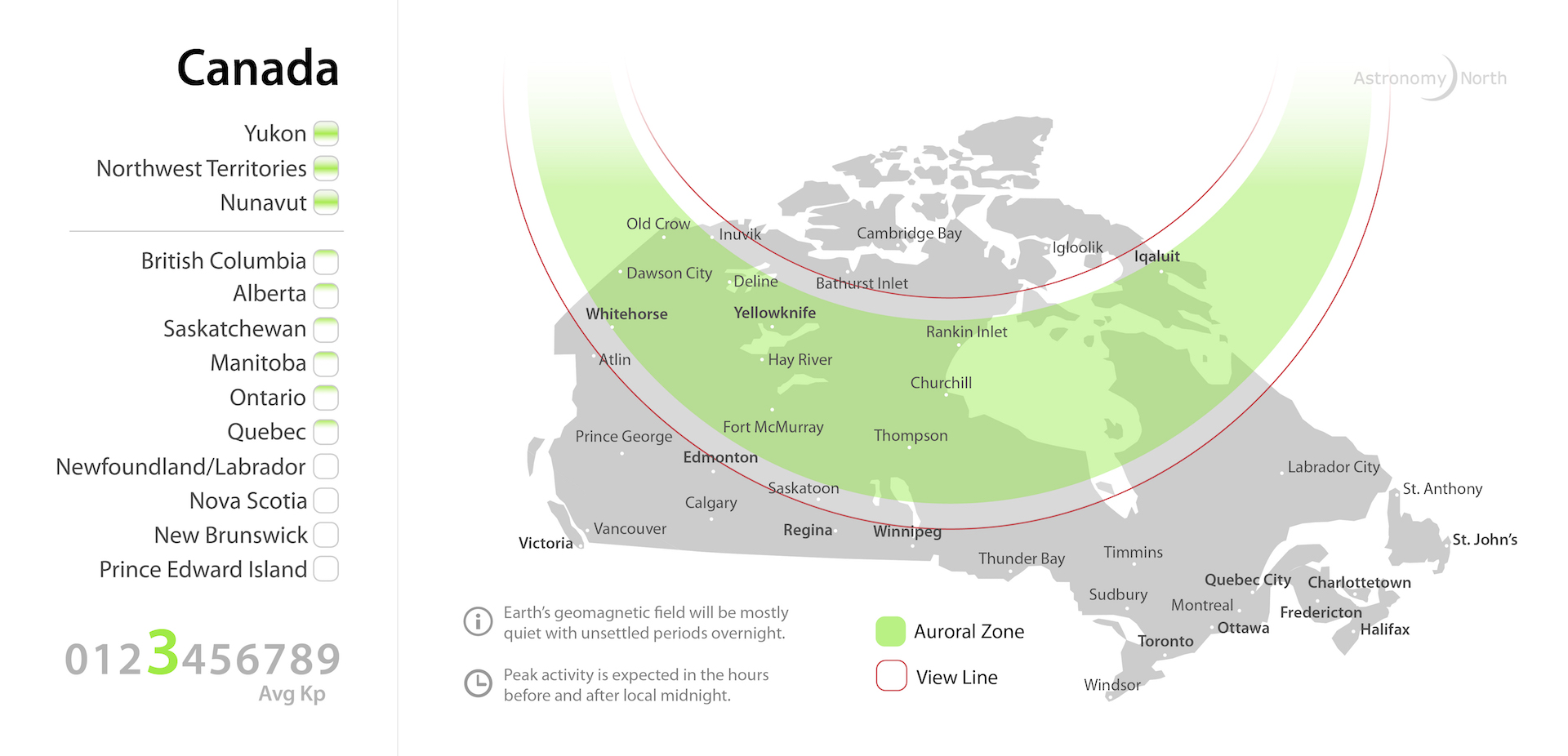Churchill, MB
Tonight

MODERATE
Evening:
Prob: 10%
Overnight:
Prob: 30%
Location: Churchill, Manitoba
Geographic: 59° N / 94° W
Geomagnetic: 67° N / 29° W
Conditions: Geomagnetic field conditions will be mostly quiet with unsettled periods overnight.
Activity: Watch for auroras above the northern horizon and overhead.
Storm Watch: No geomagnetic storm watch has been issued for tonight.
No Storm Watch in Effect
Current Storm Watch Timeline: Click here
Latest Solar Wind Arrival Time Predictions: Click here
Long-Term Forecast
April 25

MOD
Evening:
Prob: 10%
Overnight:
Prob: 35%
April 26

MOD
Evening:
Prob: 15%
Overnight:
Prob: 45%
April 27

MOD
Evening:
Prob: 15%
Overnight:
Prob: 45%
April 28

ACTIVE
Evening:
Prob: 10%
Overnight:
Prob: 65%
April 29

MOD
Evening:
Prob: 15%
Overnight:
Prob: 45%
April 30

ACTIVE
Evening:
Prob: 20%
Overnight:
Prob: 75%
Real-Time Data
CME Arrival Times
Monitor sunspots, solar flares, coronal holes and coronal mass ejections (CMEs).
Current Auroral Oval
See the latest 30-minute auroral oval predictions for the northern hemisphere.
Kp Index
Use the Kp Index to monitor the past three days of geomagnetic activity on Earth.
Frequently Asked Questions
What does "Probability" refer to in this forecast?
Probability refers to the probability of active auroras in the skies above the community. The term “active auroras” refers to periods of unsettled geomagnetic field conditions that result in the brightening of auroral structures.
What does "Evening" and "Overnight" refer to in this forecast?
“Evening” refers to the probability of activity auroras in the hours before local midnight. “Overnight” refers to the probability of active auroras from local midnight until sunrise.
What does "CALM" mean?
When the forecast is CALM it is indicating that geomagnetic field conditions are relatively calm and therefore the auroras will also be relatively calm. It will still be possible to observe auroras in the hours before and after local midnight, however the auroras may be difficult to see with the unaided eye and will likely be slow-moving (which can be great for aurora photography). When the forecast is CALM, communities located between 68°N and 70°N magnetic latitude will be well positioned to observe gentle auroras overhead, while communities 4-8° further north or 4-8° further south will be well positioned to see the same auroras above the horizon (looking north or looking south, depending on the location of the community).
What does "MODERATE" mean?
When the forecast is MODERATE it is indicating that Earth’s magnetic field is likely to become unsettled at some point during the evening or overnight, resulting in isolated periods of vibrant, fast-moving auroras, immediately followed by diffuse auroras. These conditions are often the result of substorms, which are periods of geomagnetic turbulence that occur approximately every 4 hours as part of a natural process in Earth’s magnetic field. When conditions are MODERATE, communities located between 66°N and 70°N magnetic latitude will be well positioned to observe periods of vibrant, fast-moving auroras overhead, while communities 4-8° further north or 4-8° further south (magnetically) will be well positioned to see the same auroras above the horizon (looking north or south, depending on the location of the community).
What does "ACTIVE" mean?
When the forecast is ACTIVE it is indicating that Earth’s magnetic field is likely to become unsettled for a prolonged period of time, resulting in long-duration auroral events. These conditions are often the result of enhanced solar wind speeds that originate from an active region on the Sun. As the incoming solar wind sweeps past Earth, it can trigger geomagnetic storms – where turbulence in the magnetic field is intense enough to spark visible auroras both at high latitudes and periodically at mid latitudes (often during the onset of the storm). For observers in the North, it can mean multiple periods of vibrant, fast-moving auroras, as well as pulsating auroras and long-duration diffuse auroras which can vary in brightness and intensity for many hours. So, in a nutshell, when the forecast indicates “ACTIVE” it means there is a high probability auroras will be visible and that activity may include multiple periods of vibrant and fast-moving auroras, along with long-duration diffuse auroras. When conditions are ACTIVE, communities located between 64°N and 72°N magnetic latitude will be well positioned to observe active auroras overhead, while communities 5-10° further north or 5-10° further south (magnetically) will be well positioned to see the same auroras above the horizon – looking north or looking south, depending on the location of the community.
How often is the forecast updated?
The Astronomy North aurora forecast is updated by volunteers daily before 2:00 p.m. Mountain Time, but may be updated multiple times when geomagnetic storms are in the forecast in order to reflect changing conditions.

